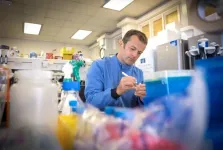(Press-News.org) Lacquers, paint, concrete—and even ketchup or orange juice: Suspensions are widespread in industry and everyday life. By a suspension, materials scientists mean a liquid in which tiny, insoluble solid particles are evenly distributed. If the concentration of particles in such a mixture is very high, phenomena can be observed that contradict our everyday understanding of a liquid. For example, these so-called non-Newtonian fluids suddenly become more viscous when a strong force acts upon them. For a brief moment, the liquid behaves like a solid.
This sudden thickening is caused by the particles present in the suspension. If the suspension is deformed, the particles have to rearrange themselves. From an energy perspective, it is more advantageous if they roll past each other whenever possible. It is only when this is no longer possible, e.g. because several particles become jammed, that they have to slide relative to each other. However, sliding requires much more force and thus the liquid feels macroscopically more viscous.
The interactions that occur on a microscopically small scale therefore affect the entire system and they determine how a suspension flows. To optimise the suspension and specifically influence its flow characteristics, scientists must therefore understand the magnitude of the frictional forces between the individual particles.
What did the scientists investigate?
ETH materials researchers led by Lucio Isa, Professor of Interfaces and Soft Matter, developed a method of measuring the frictional forces between individual particles only a few micrometres in diameter.
The researchers used a so-called atomic force microscope for their measurements. Doctoral student Simon Scherrer first developed a microscopically small holder, which serves to capture one single spherical particle. Then they move this “trapped” particle over a flat surface with the same characteristics as the particle, using the atomic force microscope. In this way, the researchers were able to imitate two particles moving past each other and measure the tiny forces between the surfaces.
Why is this so crucial?
The particles examined are tiny – a mere 12 micrometres, i.e. 12 millionths of a metre, in diameter. It was correspondingly difficult to develop a suitable measurement technique to measure the rolling friction occurring on the particle. Making a suitable holder proved to be particularly challenging. “I must have developed 50 versions until I found one that met the requirements”, Scherrer reveals.
The researchers made different particles in order to understand how the surface of the tiny particles affects the behaviour of the suspension. “Particles with a smooth or very slippery surface simply slid past each other regardless of how firmly we pressed them together”, Scherrer explains.
The situation with rough or sticky particles was very different, as these particles engage with each other like gearwheels and they roll with little resistance. Lastly, the researchers fixed the particles in the holder in order to measure their sliding friction. This friction is many times higher than the rolling friction and it explains the dramatic thickening of the suspensions.
What purpose does this serve?
The researchers were able to derive the coefficients for the rolling and sliding friction of the respective particles directly from their measurements. These figures can be used in computer models to simulate suspensions with a high fraction of particles, for example, and thereby to determine the optimum flow characteristics. These insights into the microscopic mechanisms that are the root cause of the thickening are opening up new approaches for optimising suspensions for applications in industry, construction or everyday life.
Among others, the beneficiaries might include the concrete industry or microelectronics manufacturers. The latter are already using dense suspensions with metallic, conductive particles in order to solder components to circuit boards. The solder paste is pressed through narrow nozzles. If the pressure is too great, the paste can suddenly thicken and clog up the nozzle.
“In order to prevent this behaviour and optimise such suspensions, we have to know precisely how particles behave on a microscale and what forces occur in the process”, Isa says.
Reference
Scherrer S, Ramakrishna SN, Niggel V, Hsu C-P, Style RW, Spencer ND, Isa, L. Characterizing sliding and rolling contacts between single particles, PNAS March 6, 2025122 (10) e2411414122 DOI: 10.1073/pnas.2411414122
END
Rolling particles make suspensions more fluid
2025-04-10
ELSE PRESS RELEASES FROM THIS DATE:
Research fine tunes tools used to search for genetic causes of asthma
2025-04-10
Genome wide association studies (GWAS) have identified hundreds of genome regions containing thousands of genetic variants associated with asthma, but it’s still not clear which variants have an actual causal link to the disease. This “variant-to-function” gap is one of the biggest challenges to the usefulness of these genomic studies and has motivated researchers to develop new tools to make sense of GWAS results.
A new study by researchers from the University of Chicago combines genetic data and improved computational tools to look more closely ...
Meditation and critical thinking are the ‘key to meaningful AI use’
2025-04-10
People should learn to meditate and hone their critical thinking skills as AI becomes more integrated into daily lives, an expert suggests.
Digital strategy expert Giulio Toscani has spoken with 150 AI experts across 50 countries to understand the challenges and opportunities around human interactions with artificial intelligence.
He argues in his new book, Augmented: prAIority to Enhance Human Judgment through Data and AI, that as humans operate largely unconsciously by design, they are inclined toward immediacy and instant rewards, often overlooking potential ...
Studies shows new class of antibiotic is effective in tackling MRSA
2025-04-10
The development of new antibiotics to treat superbugs and other bacterial infections is a global priority, with the rate of infections that cannot be treated with current antibiotics rising and presenting one of the biggest threats to human health.
In line with that, new research has shown a daily dose of epidermicin NI01 – an antibiotic compound developed by University of Plymouth spinout company Amprologix – is as effective at removing Methicillin-resistant Staphylococcus aureus (MRSA) as the current standard of care.
The results were achieved through a robust skin MRSA infection model, and those behind the research say it justifies ...
Certain nasal bacteria may boost the risk for COVID-19 infection, study finds
2025-04-10
WASHINGTON (April 9, 2025) — A new study from researchers at the George Washington University has found that certain bacteria living in the nose may influence how likely someone is to get a COVID-19 infection. Published in EBioMedicine, the research reveals that certain types of nasal bacteria can affect the levels of key proteins the virus needs to enter human cells, offering new insight into why some people are more vulnerable to COVID-19 than others.
“We’ve known that the virus SARS-CoV-2 enters the body through the respiratory tract, with the nose being a key entry point. What’s new—and surprising—is that bacteria in our noses ...
Europe's population is adapting better to cold than to heat
2025-04-09
A study led by the Barcelona Institute for Global Health (ISGlobal), a centre supported by the "la Caixa" Foundation, has shown that Europe has adapted better to low temperatures than to high temperatures over the last two decades. The research, carried out in collaboration with the Barcelona Supercomputing Centre (BSC) and published in The Lancet Planetary Health, shows that there has been a significant decrease in cold-related mortality risk in recent years compared to the first decade of the 2000s. There has also been a reduction in the risk of heat-related ...
Ancient tools from a South African cave reveal connections between prehistoric people
2025-04-09
In a cave overlooking the ocean on the southern coast of South Africa, archaeologists discovered thousands of stone tools, created by ancient humans roughly 20,000 years ago. By examining tiny details in the chipped edges of the blades and stones, archaeologists are able to tell how the tools were made. In a new study published in the Journal of Paleolithic Archaeology, researchers analyzed these stone tools and discussed how the different techniques used to make them hint at the ways that prehistoric people traveled, interacted, and shared their craft.
“This is an important insight into how people who lived in this region ...
World’s first birth following conception with a fully automated remotely operated ICSI system
2025-04-09
10 April 2025: The world’s first baby has been born following conception with a fully automated, digitally controlled intracytoplasmic sperm injection (ICSI) system. ICSI, developed and adopted into widespread use in the 1990s and now a routine method of assisted conception, achieves fertilisation by injecting a single sperm cell into the centre of a mature egg.
The details are reported today in the peer-review medical journal Reproductive Biomedicine Online.(1) The automated system was described and developed by a multidisciplinary team of specialists from Conceivable ...
Girls’ education projects succeed when whole communities ‘live the change’ and carry it forward
2025-04-09
Education projects supporting marginalised girls in lower-income countries are more likely to achieve lasting transformations when they mobilise young women and their communities as “agents of change”, a new report indicates.
The recommendation comes from the latest evaluation of the Girls’ Education Challenge: a UK Government-supported initiative which has funded projects reaching more than 1.6 million girls. The University of Cambridge-led study finds that these projects initiated “virtuous cycles” of change – particularly by rooting themselves in communities and empowering young women to lead the way.
In ...
European bird declines linked to range of climatic conditions experienced
2025-04-09
New research suggests conservation efforts could more effectively identify and protect bird species at greatest risk from climate change by better understanding the range of specific conditions they need to thrive.
The study, led by the University of East Anglia (UEA), examined the relationship between the extent of the climatic conditions that species tolerate and in which populations can survive - known as climatic niche breadth - and their likelihood of declining in response to climate change.
For species inhabiting a similar area of geographic space, those able to tolerate ...
'Hidden galaxies' could be smoking gun in universe riddle
2025-04-09
Astronomers have peered back in time to find what looks like a population of 'hidden' galaxies that could hold the key to unlocking some of the universe's secrets.
If their existence is confirmed it would "effectively break current models of galaxy numbers and evolution".
The possible galaxies may also provide the missing piece of the puzzle for the energy generation in the universe in infrared light.
That's because their combined light would be enough to top-up the energy budget of the universe to the maximum we observe, effectively ...





